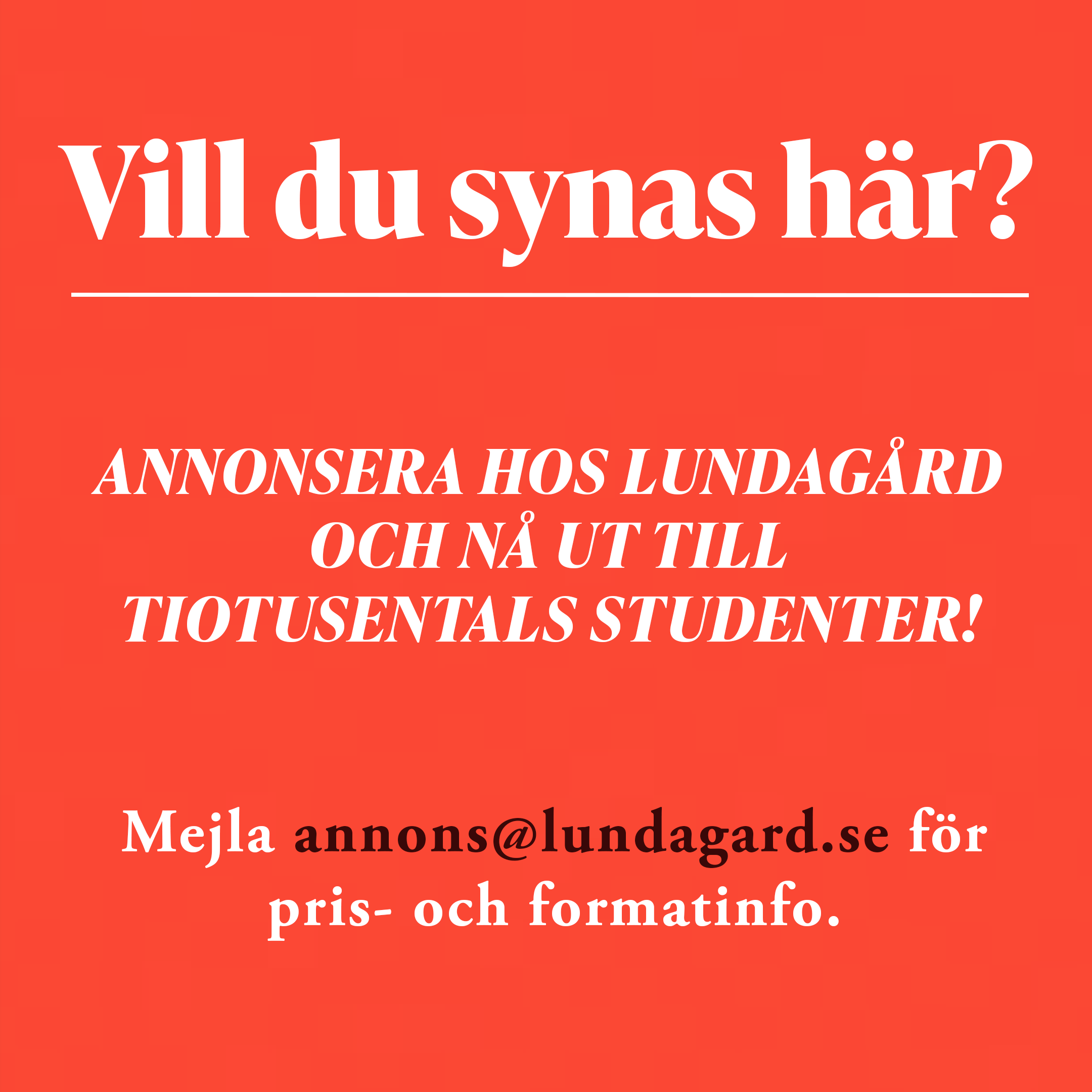Every year, around 1 400 exchange students come to Lund University. Australian Fiona Soper was one of them. This is an account of her six month stay in Sweden.
Wednesday, August the 16th at 1.04 PM
It is a sunny day, past midday, and the gravel in front of AF-borgen is dusty. Yellow marks in the grass by the fountain give away that Lundakarnevalen -Lund’s Carnival – was held here three months ago. Yesterday, the atmosphere of this area, Lundagård, was sleepy. Today, English, French and German is buzzing across the park. Mentors dressed in red university t-shirts are talking on walkie-talkies and minibuses are busy picking up students and shuttling them to student quarters. In all, more than 900 students will pass AF-borgen on this Arrival day.
Fiona Soper, 19 years old and from Brisbane in Australia, is sitting on a fence, shielding her eyes from the sun with her hand. She is now registered at the university; she has received the timetable for her Swedish course and a house key, as well as bought a ticket for a Welcome party. Now all she has to do is wait for a lift to her student accommodation to come.
-This seems like a beautiful place she says, attempting to conceal a yawn. Her flight left London early this morning.
The students who have gathered in front of the sign that says ‘The Old Fire Station’ are looking curiously at each other. Some of them start to chat.
During the short ride towards the old fire station they gaze through the windows.
-Shit, this place is central. Why am I not living here, one of the mentors jealously exclaims. After a quick unloading, the minibus turns back towards the AF-borgen. Seven lost exchange students are left on their own on the warm asphalt.
-Where is the way in? Fiona pulls at a glass door. It is locked. Then one guy tries his key, and it fits.
Fiona walks inside, and finds her room directly to the right, on the bottom floor. It has a big arched window.
– It’s bigger than I thought, she says.
Tuesday, August the 29th at 8.55 AM
The calendar says it is August but a change in the morning air gives away that September is coming.
-I am doing okay in the Swedish course, but one thing I still find hard to let go of is that ‘drag’ in Swedish means ‘pull’, Fiona says smiling. There is a dreary echo inside the cellar room in AF-borgen. There are 22 people in her group, but only five are present when the teacher, Eva Borgh, says a well-articulated ‘God morgon!’ (‘Good morning’) The course is not just about studying the language. It is also meant to serve as an introduction to Swedish society. Eva Borgh’s eagle eye spots that one of the students has brought a dispatch note. She quickly explains how the postal service works in Sweden. Then she talks about the meaning of ‘långlördag’ (a Saturday when the shops’ opening hours are longer).
The course has reached its last day, which means that there will be an exam. Students are divided into groups and receive tasks on small pieces of paper. Fiona’s group is asked to go out and ask for the way to Domkyrkan – the cathedral. They are also instructed to ask the staff how much some articles cost in Saluhallen – the market hall. When we leave the room Malte Wock from Germany asks sceptically: “Is this our examination?” The group wait until the cathedral is out of sight before they start asking people how to get there.
Now for the next assignment, Saluhallen. We pass the blue polling hut belonging to the Swedish Social Democrats and the recently opened textile shop Hemtex. By the bus shelters of Botulfsplatsen, Malte triumphantly points in the right direction. Once inside the market hall, we slow down again. ”They are going to think that we are weird if we ask about something and then don’t buy it,” he says. Fiona nervously turns the pages of her writing pad in front of the butchers’ stall. “Har ni kotlett?”, ”Vad kostar kotlett?” (“Do you have cutlets?”, ”How much is a cutlet?”) She makes careful notes of the answers. Every Swedish figure is followed by a few seconds of counting on fingers and mental arithmetic. “Etthundratjugonio kronor?” ”hm, one hundred and twenty nine”. Malte concludes: ”Kan ni göra köttbullar? Av kött?”. (”Can you make meatballs?” ”Made with meat?”). The assistant nods.
-Where are all the Swedish students; Fiona wonders before I leave her outside AF-borgen.
Tuesday, October the 31st at 10.15 AM
The small laboratory on the third floor in Ekologihuset up at LTH (The Faculty of Engineering) is lit by lamps for the plants. Fiona has a school assignment with Pelle Boberg, who is on the same course. There are seeds at different stages of germination in plastic jars. On another work surface, air is pumped into test tubes containing aquatic plants.
– Education here is very different. At home, in Australia we have many exams and tests but here we have small projects every week and ‘hemtentamen’ (an exam that you do at home). Having a hemtentamen at a university seems ridiculous to an Australian but somehow it actually works though, Fiona says looking up from the plants.
She tells me about how amazed she is with nature in Sweden.
-When you go on trips with universities in Australia, you have to fill in lots of forms. “Yes, I am aware that I may get bitten by snakes, spiders and ticks.” Even when we go to the beach there are loads of things to worry about like sharks, jellyfishes and stingrays. When we were on a day out to Ringsjön (a lake in Scania) though, there was nothing to be afraid of, nothing there was dangerous. That felt strange, she says.
Having spent slightly more than two months in Lund, the city has become part of everyday life to Fiona although she has not quite become used to all the spare time she has here.
-In Australia, all my friends, without exception, have some kind of job on the side. I do waitressing and I coach a debate team in an upper secondary school. Here, I haven’t met one student who works on the side. You Swedes fulfil the stereotype of the partying, irresponsible student more than we do, she says.
Despite this, she has adjusted quite quickly to her new situation. She reels off the names of the nations (compulsory student clubs) as if they were synonymous with the days of the week:
-VG’s Wednesdays, Lund’s Thursdays, Halland’s Fridays and Östgöta on Saturdays.
Sunday, December the 10th at 9.15 PM
A collection of makeshift furniture has been placed in the middle of the bare kitchen in Brandstationen: A kitchen table, a desk and a bedside table all in a row. You have to make do with what you’ve got when you have 30 guests coming for dinner.
Every Sunday, an exchange student invites the others over for dinner, and serves food local to her/his country. Today, it’s Kirsty MacFarlane from Scotland. She anxiously watches over the pots and pans. Chicken, lentils and a Whisky sauce is on the menu. And, for the daredevils: haggis that Kirsty’s mum sent by post across the North Sea.
-It doesn’t taste bad, but I feel like throwing up anyway, James Dicker from Manchester says of the Scottish national dish.
When the photographer from Lundagård is introduced, eyebrows are raised.
– From Sweden? Really?
A discussion about the difficulty of meeting Swedish people starts.
– It is a shame that we are not placed in ordinary Swedish student housing. At the student nations you meet mostly other exchange students. The Swedes that are there already have their circle of friends, Kirsty says.
What about the mentor groups?
-Some groups work better than others and have many activities. Still, there are just two or three Swedes and around 30 exchange students. The place where we have met more Swedes is at the kebab shop when the nations have closed, Fiona says.
Maybe Swedish students find it difficult keeping up with the exchange students. The combination of fewer lessons and an often relaxed attitude towards their studies give the exchange students oceans of spare time. This shines through from the stories in the kitchen. The inhabitants talk about trips, parties and fancy-dress parties. The latest theme was the Animal World and many people put a lot of time and effort into their costumes. One of the most impressive was a guy who turned up dressed as a huge jellyfish.
But all the stories carry a twang of pensive melancholy. The first flights back home leave in one week’s time.
Tuesday, January the 16th at 6.07 PM
It’s raining outside, but the kitchen lights are on in Brandstationen. Two guys are eating pasta with pesto sauce and drinking Millennium beer. On the wall there is a newspaper clipping about one of the guys. During the recent storm, he put himself in a shopping trolley, armed with a shower curtain, and sailed along the road called Kävlingevägen. A new generation has moved into the student lodgings.
The last few days Fiona has been constantly asked those questions that she herself had six months ago: “What nation should I join? Where can I buy cheap food? How do you book train tickets in Sweden?”
Fiona spent the Christmas holidays with her father in London.
-When I came back after Christmas, I felt it straight away in my stomach. There were only three of us left. The silence was so strange, Fiona says.
-I never thought you could get to know so many people at once in such a short time. We have done everything together.
As we talk, she packs her Swedish life into a big suitcase. Half of the things she has sent off already, before Christmas.
She has souvenirs from a whole range of countries hanging on the wall. In the last six months she has visited ten countries, if you count the skiing holiday in Austria that is planned for before her journey back home. There are mind maps and notes hanging on the walls too. Fiona will have her last exam tomorrow.
-Ten credits, I have never had a bigger exam. If I don’t pass, I will lose my university scholarship. That is 25 000 Swedish crowns, she says, but she is not looking too worried.
Thursday, January the 18th at 9.39 PM
The weather forecast is promising snow, but it is sunny and above zero at Lund Central Station. Fiona didn’t get to experience a winter wonderland during her stay in Sweden.
The 9.39 train to Kastrup leaves according to the timetable. She has a Swedish flag in her suitcase. Good-bye, Sweden!
Photo: Jens Lennartsson
Translation: Carolina Wickander








